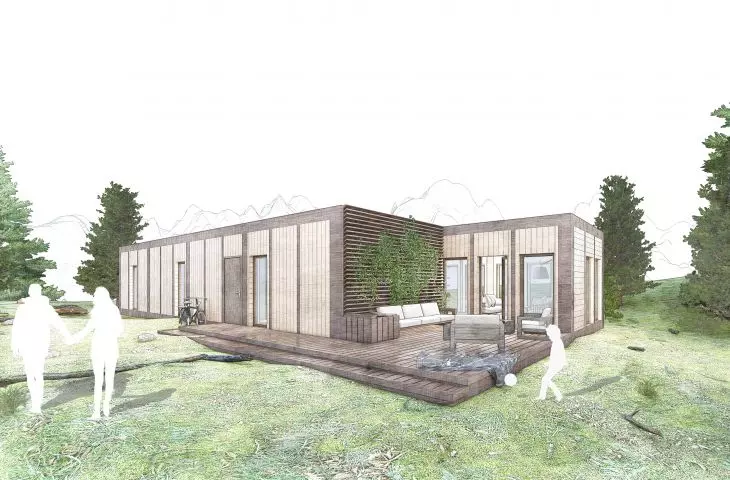Architecture students of Wroclaw University of Technology: Tamila Kramar, Weronika Piotrowska, Kinga Szymczyk and Damian Zablocki, took on the challenge of the international Modular Home 2 competition organized by the Buildner platform during their internship at the UrbanGEOS studio under the guidance of Maciej Szczepanski. Their concept of an easy-to-construct modular home that can be built anywhere in the world was shortlisted for the competition.
The goal of the international ModularHome 2 competition was to design a modular home that can be built in any form and layout, erecting it in a location of choice: rural, urban or suburban. The jury was looking for design concepts that make efficient use of materials, incorporate prefabrication, are easy to transport and reduce energy consumption.
Module Life Style can be built on any site
© Tamila Kramar, Weronika Piotrowska, Kinga Szymczyk, Damian Zablocki, Maciej Szczepanski
The entries submitted to the competition were judged by a jury consisting of Bárbara Bardin (Canobardin, Spain), Pilar Cano-Lasso (delavegacanolasso, Spain), Sarah Broadstock (Studio Bark, UK), Mark Gabbertas (Gabbertas Studio, UK), Inés Olavarrieta (selgascano, Spain). The architects awarded three grand prizes (First Prize went to Han Kuo of Taiwan), six honorable mentions, and announced the short list for the competition. It was on this list that the Module Life Style project by a Polish student team that is part of theUrbanGEOSstudio was included . The work was done under the direction of architect Maciej Szczepanski.
Module Life Style project, projection
© Tamila Kramar, Weronika Piotrowska, Kinga Szymczyk, Damian Zablocki, Maciej Szczepański
Module Life Style
We started working on the project and deciding to participate in the competition back in April this year. Our first task turned out to be to answer the question, who would the title Modular Home actually serve? In the course of sketching and first concepts, we thought about the sources of the housing problem. We are not indifferent to the increasingly perceived catastrophic climate change, we recognize its impact on our lives and would like to prevent, at least minimally, these drastic changes. We have focused on responding to the problem of inflation, which, after two years of pandemonium, is hitting the world economy with increasing force. The repercussions of this, among other things, are huge changes in the housing market, the effects of which we can already observe. For us, the definition of modular architecture is all about offering versatile solutions for efficient, sustainable spaces. Repeatable, flexible modules can provide configurable and well-thought-out solutions for projects without incurring excessive costs, while adapting individually to users. Prefabrication, efficient use of materials, reduced transportation requirements and ease of on-site installation have the potential to reduce the energy contained in a project, the authors say.
The house can be expanded by adding more modules
© Tamila Kramar, Weronika Piotrowska, Kinga Szymczyk, Damian Zablocki, Maciej Szczepanski
self-sufficient modular house
In response to the perceived problems, the young architects proposed an object that can be built anywhere in the world, is easy to transport and allows free creation of space. They also made sure that the house would be self-sufficient. As they mention, they wanted to focus on the multifunctionality of the space, on the freedom of layout, and on convenience and installation on any type of surface, so that the house could stand anywhere. In addition, it was important to them that the design be eco-friendly and capable of generating energy on its own.
When thinking about creating the concept, we had to face some limitations imposed by the organizers. We had to create a module with a maximum height of 3.6, a maximum width of 4.2 and a maximum module length of 18 meters. The requirement of the organizers was to create a design for a 2+1 family model. After many trials and the development of various combinations, we created sets of modules that have fixed interior dimensions of 3.6×3.6 meters, which gives plenty of room for a variety of space arrangements. We decided that one module would constitute one usable space," the designers explain.
Sample interior, open living area
© Tamila Kramar, Weronika Piotrowska, Kinga Szymczyk, Damian Zablocki, Maciej Szczepanski
The proposal is to create several modules, which, after transformation, could also function with other family models. Depending on the terrain, the house is positioned in relation to the directions of the world so that the most glazed facade is exposed to the sun. This makes it possible to use photovoltaic panels placed in the window panes. Solar energy means that the house can be completely independent of fixed connections. In the functional layout for a 2+1 family, the authors proposed a spacious living room connected to the dining room, while a large kitchen, bathroom, technical room are located in the central part of the house. The child's bedroom and the parents' bedroom are open to the south.
The walls are selected from the catalog
© Tamila Kramar, Weronika Piotrowska, Kinga Szymczyk, Damian Zablocki, Maciej Szczepanski
construction like a puzzle
Thehouse can be shaped freely, adjusting to the number of users and choosing specific modules. Thanks to the developed catalog of walls, the design is flexible. Walls like "puzzlepieces", provide countless opportunities to create different variations. Another important element is adjustable telescopic legs - they replace the traditional foundation, which prolongs construction and generates costs. Thanks to the legs, the house can be erected even on challenging terrain. The authors anticipate that it will be possible to assemble it on rocky, sandy terrain or over water.
technical room solutions
© Tamila Kramar, Weronika Piotrowska, Kinga Szymczyk, Damian Zablocki, Maciej Szczepanski
This is the first competition project we had the pleasure of creating during our internship at UrbanGEOS. We are even more pleasantly surprised that our project has been noticed on the international arena. We are currently working on more competition concepts, which we hope will see the light of day in the near future," the authors add.





































